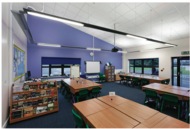Schools learn the energy benefits of lighting control

Typical of many new schools throughout England which are achieving major reductions in electricity consumption using Ex-or lighting controls is Lakeside Primary School in Derby.


Ecobat Battery re-launches as Veloris
Following its sale from the Ecobat Group and a subsequent comprehensive review of its position in and value to the market, Europe’s largest independent battery distributor is now Veloris.
Baxi survey reveals care home leaders need support to achieve heat decarbonisation goals
Baxi recently surveyed over 400 senior and middle management care home managers in both the private and public sector this summer in an effort to understand the enablers required to help decarbonise the sector.